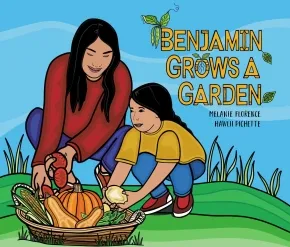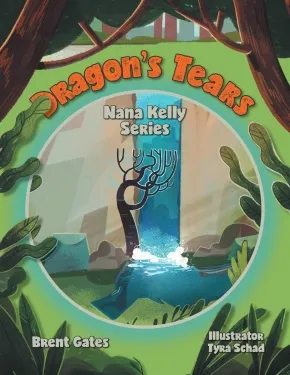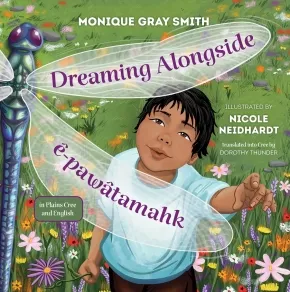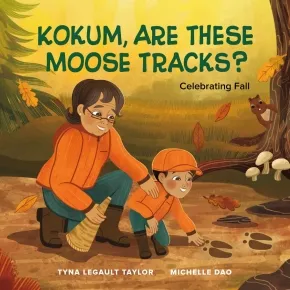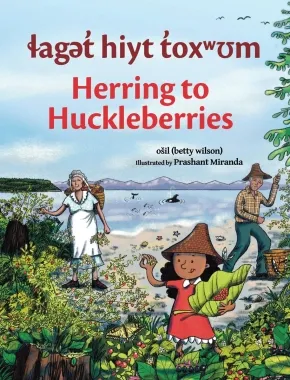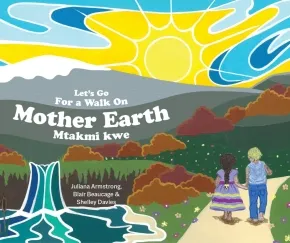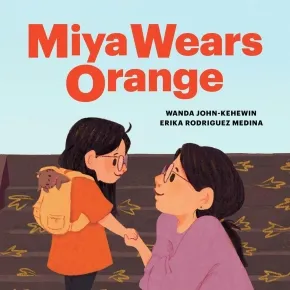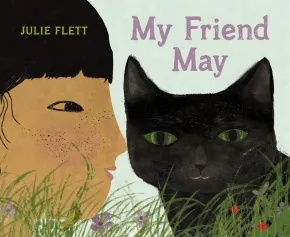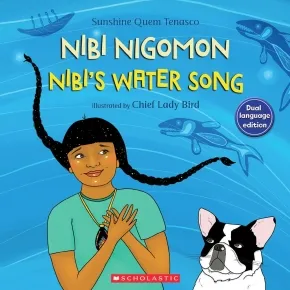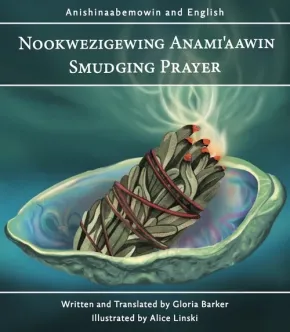
First Nations
1
-
15
of
324 Results;
Sort By
Go To
of 22
Askemawso
$14.95
Format:
Paperback
ISBN / Barcode: 9781998223305
Synopsis:
Synopsis:
The story follows a wəlastəkewi skitap (man) named Askəmawsit along with his friends, Mahtəkwehs and Kahkakohs. It is the story of his quest of finding long lost Kelowəskap, in hopes that he can grant Askəmawsit’s biggest wish to live forever.
Educator Information
Recommended for ages 5 to 8.
Additional Information
36 pages | 9.25" x 7.25" | Paperback
Benjamin Grows a Garden
$21.99
Artists:
Format:
Hardcover
Text Content Territories:
Indigenous Canadian; First Nations; Cree (Nehiyawak);
ISBN / Barcode: 9781525303210
Synopsis:
Synopsis:
Readers follow along step-by-step as Benjamin plants and cares for his garden and imagines the harvest to come.
Benjamin loves springtime. The grass grows bright green, the birds sing sweet songs and, best of all, Benjamin and his mother start their garden. In just the right order, they plant mahtâmin (corn), pîmiciwacis (beans), and osawipak (squash) for Three Sisters Soup. They plant strawberries to serve with bannock, then zucchini, tomatoes, cucumbers. Benjamin and his mom lovingly tend to the garden and watch it grow into a plentiful harvest with enough to share. Throughout the whole summer, Benjamin dreams about the fall, when they’ll have all the ingredients for a feast – and everyone will be invited!
In this heartwarming story, award-winning author Melanie Florence evocatively portrays the pleasures and rewards of growing and sharing food. The steps of the gardening process – digging holes, planting seeds, watering – are carefully described, and the yearly cycle of growing, harvesting, eating and then starting again the next year is emphasized. Special attention is paid to the tradition of planting corn, beans and squash together so that each plant by its nature helps the others grow. Benjamin and his mother use Cree words throughout the story, and a pronunciation guide is included at the back of the book for further inquiry. Vivid illustrations by Hawlii Pichette make this a perfect follow-up to the author and illustrator duo’s previous book, Benjamin’s Thunderstorm.
Reviews
"A comforting tale of cohabitation between humans and nature." — School Library Journal, April 2025
Educator Information
Recommended for ages 3 to 7.
Includes Cree words throughout the story. A pronunciation guide is included at the back of the book.
Curriculum Connections: Caring; Growth and changes in plants; Indigenous peoples; Patience; Plants; Word recognition
This book is part of the Benjamin Outdoors series. From dancing in the rain with thunder for a drum to planting a vegetable garden with his mom, Benjamin loves being in nature. With evocative text and vibrant art, this delightful picture book series celebrates the joys of spending time outdoors and weaves in nature-related Cree words.
Additional Information
40 pages | 10.00" x 8.50" | Hardcover
Celebrating Potlatches
$21.95
Artists:
Format:
Hardcover
Text Content Territories:
Indigenous Canadian; First Nations; Tsimshian (Ts'msyen); Nisga'a;
ISBN / Barcode: 978-1-77174-656-4
Synopsis:
Synopsis:
“Papa, what is a Potlatch?”
Inspired by Ts’msyen Chief William Beynon’s historic notebooks on Potlatches in the Gitxsan village of Gitsegukla, Celebrating Potlatches pairs intergenerational storytelling with beautiful illustrations to honour Indigenous traditions. From the award-winning author of Oolichan Moon and the accomplished illustrator of Be a Good Ancestor, this book recounts the 1885 Potlatch ban and the resilience of the communities who fought to keep their traditions alive.
Reviews
“Heartfelt and timely, Celebrating Potlatches gifts readers with cultural teachings through an intergenerational account of Indigenous resilience. This book is a beautiful tribute to the author’s great-grandfather, William Beynon, whose life’s work documenting oral histories of Sm’algya̱x-speaking Peoples and their Potlatches continues to be foundational to our cultural resurgence today.” – Sm Łoodm ‘Nüüsm (Dr. Mique’l Dangeli), Sm’algya̱x language expert and Assistant Professor of Indigenous Arts at the University of Victoria
“This beautiful book shares the importance of community, culture, and identity. As you make your way through the pictures and words, they bring you to an understanding of how important the Potlatch ceremony was and continues to be for Indigenous Peoples.” – Carolyn Roberts, educator, speaker, and author of Re-Storying Education
Educator Information
Recommended for ages 4 to 8.
Through this conversational historic account, readers can learn alongside the narrator as his Papa shares his wisdom about the rich history of the Potlatch.
Curriculum Connections
- Early literacy – listening, reading, and discussing
- Art – traditional Indigenous art, drumming, and regalia
- Social studies – the 1885 Potlatch ban, history of Indigenous Peoples, connection to community
- Social responsibility – uplifting ourselves and others, honouring traditions
- Indigenous knowledge and traditions – traditional teachings, Potlatch ceremonies, intergenerational storytelling
Two free, downloadable lesson plans—one for kindergarten to Grade 1 and one for Grades 2 to 3—provide connections to Social Studies curriculum.
Additional Information
32 Pages | 10" x 8.5" | Hardcover
Dad, Is It Time to Gather Mint?: Celebrating the Seasons
$21.95
Artists:
Format:
Hardcover
Text Content Territories:
Indigenous Canadian; First Nations; Anishinaabeg; Ojibway; Cree (Nehiyawak); Swampy Cree ; Attawapiskat;
ISBN / Barcode: 9781774921227
Synopsis:
Synopsis:
Learn about the rhythms of the seasons with Joshua in this captivating read-aloud story for ages 5 to 8.
Join Joshua as his father teaches him about traditional food harvesting.
Joshua loves being on the land. When the weather is warm, Joshua and his dad gather mint from the shores of Animbiigoo Zaagi’igan Anishinaabek (Lake Nipigon First Nation) in northeastern Ontario. But when will that be? It’s not when the leaves are changing colour. It’s not when the snow falls from the sky. It’s not when the flowers are budding. When is it time to gather mint from the land?
In the back of the book, find a glossary and pronunciation guide for the Swampy Cree and Anishinaabemowin words featured throughout the story.
Reviews
"Tyna Legault Taylor delivers a magical story of the seasons through Joshua’s sweet anticipation as he learns how to know when it is time to harvest katakipanik / gaaminomaagobagak / mint from the land. In this beautifully illustrated book, Joshua gains important land-based traditional knowledges from his father about harvesting, medicines, and Indigenous food sovereignty and learns key words in Northern Swampy Cree and Anishinaabemowin as he discovers his relationships to land. With the inclusion of a recipe for Mint From the Land Iced Tea and a glossary, this book will engage readers of all ages, but will be especially treasured by children who see themselves in Joshua’s curious and adventurous spirit!" — Barbara Parker, Associate Professor, Lakehead University
“Swampy Cree…and Anishinaabemowin words are interwoven seamlessly into the simply stated sentences. Dao’s vibrant illustrations radiate warmth and connection. Sharing land-based Indigenous knowledge, this is an informative picture-book-series opener.”—Booklist
“A warm and colourful tale that brings traditional teachings to life. This is a story from the home and the heart that the whole family will enjoy.”—Don Kelly, Gemini Award–nominated host of APTN's Fish Out of Water and Crazy Like a Lynx
“The lived experience of Joshua and his family...is a testament to the sacred connection between Indigenous people and the land. A great tool for all children to learn more about Indigenous people and Indigenous languages.”—Phil Fontaine, former National Chief of the Assembly of First Nations
Educator & Series Information
Recommended for ages 5 to 8.
Includes some Swampy Cree (n-dialect) words in brown and Anishinaabemowin words in green, but this is not a dual-language book.
The backmatter includes a Swampy Cree/Anishinaabemowin Glossary and a recipe for Mint From the Land Iced Tea.
Big Ideas: Land-Based and Place-Based Learning, Traditional Foods, Traditional Clothing, Traditional Medicine, STEM: Seasonal Cycles, STEM: Plants.
This book is part of the Joshua Learns from the Land series.
Additional Information
36 pages | 9.00" x 9.00" | Hardcover
Dragon's Tears
$16.52
Artists:
Format:
Paperback
Text Content Territories:
Indigenous Canadian; First Nations; Salish; Coast Salish; Penelakut;
ISBN / Barcode: 9781038330376
Synopsis:
Synopsis:
At Elk Falls on Vancouver Island, the children gather around the campfire, ready for one of Nana Kelly’s stories.
She tells them of a time, long ago, when dragons were born from the love of forest creatures and the flames from the Great Spirit’s fire. As the wood burned low, that love and warmth filled the logs—and the Great Spirit transformed them into glowing dragon hearts and heads. Lifted by the fire, the heads floated toward the falls, where only the rushing water could give them bodies and give them life.
But when the ancient forests were cut down, only one dragon remained. Lonely and full of sorrow, it wept—until one night, the dragon’s tear met a glowing ember . . .
Momo, carrying her heart in her mouth, must find her way to the falls before her small body fades. With help from the Princess of Peace and a river full of salmon, Momo races against time to complete her transformation into a dragon.
A story as old as the forests and the falls, Dragon’s Tears shows how love, courage, and the kindness of others can bring something beautiful back to life.
Educator Information
Recommended for ages 11 and under.
Additional Information
28 pages | 8.50" x 11.00" | Paperback
Dreaming Alongside / ê-pawâtamahk
$21.95
Artists:
Format:
Hardcover
Text Content Territories:
Indigenous Canadian; First Nations; Cree (Nehiyawak); Plains Cree;
ISBN / Barcode: 9781459843882
Synopsis:
Synopsis:
Let Dragonfly lead you on a journey of inspiration!
Following your winged guide, visit the places and things that can help you find strength in the present and imagine your amazing future. Dream alongside everything from a giant construction site and a sewing machine to the river and a blanket of moss. After your travels, Dragonfly asks: What do you like to dream about? With its mixed setting in rural and urban environments and exploration of both the natural and modern world, Dreaming Alongside gives readers permission to daydream and think of what magic their lives have the potential to hold.
Educator Information
Recommended for ages 3 to 5.
This bilingual book includes full text in both English and Plains Cree.
Translated into Plains Cree by Dorothy Thunder.
This book is available in English only: Dreaming Alongside.
Additional Information
32 pages | 9.00" x 9.00" | Hardcover
Kokum, Are These Moose Tracks?: Celebrating Fall
$21.95
Artists:
Format:
Hardcover
Text Content Territories:
Indigenous Canadian; First Nations; Anishinaabeg; Ojibway; Cree (Nehiyawak); Swampy Cree ; Attawapiskat;
ISBN / Barcode: 9781774921470
Synopsis:
Synopsis:
Young readers will get ready for autumn on a moose tracking adventure with Joshua and Kokum.
When the harvest begins every fall, Joshua looks forward to eating Kokum's delicious moose meat stew at family feasts. He loves being on the land, and he can't wait to go moose hunting with his kokum.
Joshua and Kokum are careful not to make too much noise as they look for moose tracks in the forest. There are so many different animal tracks and Joshua can find them all. But which ones are moose tracks?
In the back of the book, find a glossary and pronunciation guide for the Omushkegomowin (Swampy Cree language) and Anishaabemowin (Ojibwe language) words featured throughout the story. A wonderful cultural learning experience for 5- to 8-year-olds!
Reviews
"A great learning tool for kids! This book not only teaches Omushkegomowin and Anishinaabemowin words and how to identify different animal tracks, but also, and most importantly, it instills respect for all living creatures and consideration for Mother Nature. I hope to one day harvest a moose with my kids, but in the meantime, we’ll try Kokum’s recipe for moose meat stew." — Chuck Hughes, chef and host of Chuck and the First Peoples' Kitchen
Educator & Series Information
Recommended for ages 5 to 8.
Reading Levels:
- Fountas & Pinnell Text Level Gradient: L
- Lexile measure: 760L
This book is part of the Joshua Learns from the Land series.
Additional Information
40 pages | 8.50" x 8.50" | Hardcover
laget hiyt toxwum / Herring to Huckleberries
$24.95
Artists:
Format:
Hardcover
Text Content Territories:
Indigenous Canadian; First Nations; Salish; Coast Salish; Tla'amin (Sliammon);
ISBN / Barcode: 9781774921180
Synopsis:
Synopsis:
Join ošil and her grandparents as they harvest food along what is now called the southwest coast of British Columbia!
It’s ošil’s favourite time of year! When the seasons change and the weather grows warm, the ɬagət̓ (herring) return to the waters of the ɬaʔəmɩn Nation, located on the southwest coast of British Columbia. For ošil and her grandparents, their arrival is the beginning of a full year of harvesting traditional foods provided by the sea and land. Together they fish, pick berries, and dig for clams. Everything tastes so good. And the best part is that there is enough for everyone to share!
Connect with the land and explore traditional Indigenous ways of gathering food in this beautifully illustrated picture book written in the language spoken in Tla’amin and English. Drawn from the childhood memories of ošil (betty wilson), this book is sure to charm readers of all ages.
Reviews
“I absolutely loved this story. [It] gives readers the opportunity to experience life through the main character's eyes as she harvests traditional foods with her grandparents.The colourful images and descriptions—of herring roe, fish soup, and mashed fresh harvested berries with oven bread—are wonderful and made me wish for all these delicacies.”—Nicola I. Campbell, author of Stand Like a Cedar
“Prashant Miranda's expressive illustrations bring ošil’s story of ɬaʔəmɩn lands, language, and food to life. Whether this is an introduction to ʔayʔajuθəm or a warm trip down memory lane, as it was for me, this book will be enjoyed by readers of all ages.”—Cameron Fraser-Monroe, dancer and choreographer (Royal Winnipeg Ballet)
Educator Information
Recommended for ages 6 to 8.
Explore this captivating story that bridges generations, celebrates cultural practices, and immerses readers in the rich traditions of the Tla’amin Nation.
Connect with the land and explore traditional Indigenous ways of gathering food in this beautifully illustrated picture book written in the language spoken in ʔayʔajuθəm and English.
Dual-Language: written in the language spoken in Tla'min and English.
The backmatter includes information on traditional foods in Tla'amin, a glossary, a note from the author, and a map.
Big Ideas: Land-Based or Place-Based Learning, Aspects of Indigenous Cultures: Traditional Foods, STEM: Seasonal Cycles, STEM: Environmental Stewardship and Sustainability.
Additional Information
44 pages | 7.75" x 10.25" | Hardcover
Let's Go For a Walk on Mother Earth
$22.99
Artists:
Format:
Hardcover
Text Content Territories:
Indigenous Canadian; First Nations; Anishinaabeg;
ISBN / Barcode: 9781778540653
Synopsis:
Synopsis:
Today is a good day to go for a walk on Mother Earth.
Come on a journey with young Sachiiwin and Waawaasbiikse as they count all the wonderful animals they can see. With each new animal friend, learn their Anishinaabemowin name, and discover what makes them special.
This delightful resource for little ones from Ojibway author, Juliana Armstrong, combines concepts of counting, Anishinaabemowin language learning, and traditional teachings. Accessible, repetitive and gentle, this book offers readers a space to celebrate the beauty of language, and reflect on what guides us in our own walk on Mother Earth.
Educator Information
Recommended for ages 4 to 11.
This is not a fully dual-language book, but it includes the Anishinaabemowin name for each animal in the story.
Additional Information
32 pages | 11.00" x 8.50" | Hardcover
Little Shoes
$24.99
Format:
Hardcover
Text Content Territories:
Indigenous Canadian; First Nations; Cree (Nehiyawak);
ISBN / Barcode: 9781774881729
Synopsis:
Synopsis:
From the bestselling and Governor General's Award–winning author of On the Trapline comes a beautifully told and comforting picture book about a boy's journey to overcome generational trauma of residential schools.
Deep in the night, when James should be sleeping, he tosses and turns. He thinks about big questions, like why we don't feel dizzy when the Earth spins. He looks at the stars outside his bedroom and thinks about the night sky stories his kōkom has told him. He imagines being a moshom himself. On nights like these, he follows the moonlit path to his mother's bedroom. They talk and they cuddle, and they fall asleep just like that.
One day, James's kōkom takes him on a special walk with a big group of people. It's called a march, and it ends in front of a big pile of things: teddy bears, flowers, tobacco ties and little shoes. Kōkom tells him that this is a memorial in honor of Indigenous children who had gone to residential schools and boarding schools but didn't come home. He learns that his kōkom was sent away to one of these schools with her sister, who also didn't come home.
That night, James can't sleep so he follows the moonlit path to his mother. She explains to James that at residential school when Kōkom felt alone, she had her sister to cuddle, just like they do. And James falls asleep gathered in his mother's arms.
Includes an author note discussing the inspiration for the book.
Reviews
"Robertson (Norway House Cree Nation) sensitively approaches this history, never explicitly describing the horrors of residential schools but instead leaving space for adults to grapple with youngsters’ questions in their own ways. Though he doesn’t provide easy answers, it’s clear that familial love keeps this child buoyed. Suffused with pinks, icy blues, and deep indigos, the glowing, cartoon-style digital illustrations from McKibbin (Ojibwe) depict the ancestral bonds that keep James rooted. Honest yet age-appropriate and deeply uplifting." —Kirkus Reviews
"Cree author Robertson reteams with Ojibwe, Yoeme, and Irish artist McKibbin (The Song That Called Them Home) for this work that honors children who did not return from residential schools. . . . James and his mother’s musing on intergenerational story-sharing further contribute to themes of connection and loss in this emotional work." —Publishers Weekly
"[Robertson and McKibbin] have taken on the weighty task of presenting a catastrophic loss to young readers, but also offering hope and determination. With poetic text and images of family life that are both familiar and mystical in tone, they have achieved this goal. . . . The honesty of Little Shoes is an antidote to fear." —Imaginary Elevators
"[A] big story about generational trauma of residential schools [which] focuses on the comfort that comes from family. Maya McKibbin evokes comfort and discomfort, as well as affection and thoughtfulness, with great sensitivity. . . . [A] great discussion starter for families and classes about residential schools, about Every Child Matters, and about asking questions. But it will also inspire understanding and empathy for that which has happened so that tragedies like residential schools are not repeated." —CanLit for Little Canadians
Educator Information
Recommended for ages 3 to 7.
This book is available in French: Petits souliers
Additional Information
48 pages | 8.00" x 12.00" | Hardcover
Miya Wears Orange
$21.95
Artists:
Format:
Hardcover
Text Content Territories:
Indigenous Canadian; First Nations; Cree (Nehiyawak);
ISBN / Barcode: 9781774921258
Synopsis:
Synopsis:
A beautifully illustrated book that gently explores the complicated feelings a young girl experiences as she learns about tragedy and injustice.
Miya loves her school and she especially loves storytime. One day, her teacher shares a story about a little girl who was taken away to a residential school. The little girl wasn’t allowed to go home. Her hair was cut and she wasn’t allowed to keep her favourite doll. She was taken away from her family because she was Indigenous, just like Miya!
Miya worries the same thing will happen to her. Her mom tells her that Indigenous girls and boys aren’t forced to leave their families anymore. Miya is relieved, but she is still sad. What can she do about these feelings?
Reviews
"A moving and important story that deftly explores the fear a little Indigenous girl feels when she learns the truth about residential schools. Miya finds solace in her mom’s words, and readers will too. A sensitive explanation of residential schools that prioritizes the emotional safety of all readers, especially Indigenous children."— Jen Moss, lecturer at UBC's School of Creative Writing
"opens the door to an important discussion about residential schools" - School Library Journal
Educator Information
Recommended for ages 6 to 8.
In this story, a young girl named Miya feels scared and sad after learning about residential schools, but she learns how to cope with the help of her mother.
A gentle story about big feelings and finding courage.
Big Ideas: Social-Emotional Learning: Emotions and Feelings; Social Justice: Intergenerational Trauma, Residential Schools.
This book is available in French: Le Chandail orange de Miya.
Additional Information
40 pages | 8.50" x 8.50" | Hardcover
Mother Earth: My Favourite Artist
$22.99
Artists:
Format:
Hardcover
Text Content Territories:
Indigenous Canadian; First Nations; Cree (Nehiyawak);
ISBN / Barcode: 9781778540615
Synopsis:
Synopsis:
Have you ever considered Mother Earth to be an artist? A shiny rock, the guiding tracks of a bird, a colourful sunset - what beauty do you see on Mother Earth?
Award-winning Indigenous author, CBC journalist, and Poet Laureate of Saskatchewan (2021-2023) Carol Rose GoldenEagle brings readers a radiant tribute to the artwork within the everyday. Paired with stunning illustrations by Hawlii Pichette, Mother Earth: My Favourite Artist encourages us to share in the simple wonder of nature, and honour the precious magnificence of Mother Earth and all of our relatives.
Educator Information
Recommended for ages 5+.
A teacher lesson plan is available: Mother Earth: My Favourite Artist Teacher Lesson Plan
Additional Information
28 pages | 11.00" x 8.50" | Hardcover
My Friend May
$23.95
Artists:
Format:
Hardcover
Text Content Territories:
Indigenous Canadian; First Nations; Cree (Nehiyawak);
ISBN / Barcode: 9781778401718
Synopsis:
Synopsis:
From the winner of the New York Times Best Illustrated Book Prize and the American Indian Youth Literature Award
I’d like to tell you a rather true story about a big black cat who started out gray. Her name was May.
Margaux and her cat May became friends when Margaux was just six years old. They grew up together, sharing countless memories along the way. But one day, May is late coming home. Where is May? Is she under the porch? Maybe on the roof?
Margaux’s nitôsis (the Cree word for auntie) helps search for May in the tall grass. But soon nitôsis needs to leave: she’s moving away to the big city, and has to pack her things into boxes. Margaux helps nitôsis, but she can’t take her mind off May. Will she ever return? nitôsis is worried, too. But little do they know, May has a surprise in store for both of them!
This fun and heartwarming story with a surprise happy ending invites readers to share their own cat stories. My Friend May is a tribute to love and the balance between all beings, and the experiences and emotions that connect us all.
My Friend May features:
- A glossary of Cree words used throughout the book
- Backmatter content that includes a pronunciation guide
Reviews
"A quiet yet affectionate tribute to familial relationships of all stripes….Cat lovers… will particularly enjoy this sweet tale."—Kirkus Reviews
"From a talented picture book creator….Readers can reflect on great stories of their own encounters with beloved animal friends and share their tales with others….delightful.”—School Library Journal
Educator Information
Recommended for ages 4 to 8.
Additional Information
40 pages | 11.00" x 9.00" | Hardcover
Nibi nigomon/Nibi's Water Song
$8.99
Format:
Paperback
Text Content Territories:
Indigenous Canadian; First Nations; Anishinaabeg;
ISBN / Barcode: 9781039700673
Synopsis:
Synopsis:
Nibi is determined to bring clean water to her community.
Nibi is the Anishinabemowin word for water. In Nibi’s Water Song, Nibi is an Indigenous girl on the search for clean water to drink. Though she is faced with repeated obstacles, Nibi’s joyful and determined energy becomes a catalyst for change and action as her community rallies around her to make clean drinking water available for all.
First published in 2020, Nibi’s Water Song was shortlisted for both the IODE Jean Throop Award and longlisted for the First Nations Communities READ Award. This dual-language edition presents the text in both English and Anishinabemowin.
Educator Information
Recommended for ages 4-8.
Dual-language: English and Anishinabemowin
Translated by Tina Nottaway. Tina is an Algonquin Anicinabe Ikwe artist and translator from Rapid Lake, Quebec. She is fluent in her language, Anicinabemowin. Tina is also a crafter and facilitates workshops on moccasin making, birchbark basket making and other cultural activities.
This resource is available in English: Nibi's Water Song
This resource is also available in French: Nibi a soif, très soif
Additional Information
32 pages | 9.51" x 9.51" | Paperback
Nookwezigewing anami'aawin / Smudging Prayer
$9.99
Artists:
Format:
Paperback
Text Content Territories:
Indigenous Canadian; First Nations; Anishinaabeg; Ojibway; Hollow Water First Nation (Waanibiigaaw / Wanipigow);
ISBN / Barcode: 9781779550224
Synopsis:
Synopsis:
Written by Gloria Barker, Language Teacher from Hollow Water First Nation, which is located on the east side of Lake Winnipeg, Canada. Hollow Water First Nation is also known as Waanibiigaaw or Wanipigow in Ojibwe. Illustrated by Alice Linski; Alice RL is a member of Ne-biimiskonaan (Skownan) First Nation, Treaty 2 Territory. Alice is a Two-Spirit Anishinaabe artist, illustrator, and art teacher based in Winnipeg, Manitoba. Alice draws inspiration from life experiences and cultural teachings. Alice blends these inspirations with a signature palette of bright, playful hues to create stunning emotional juxtapositions of trauma and grief with hope and a touch of whimsy.
Educator Information
The publisher recommends this work for all ages.
This book is delivered in a dual-language format of Anishinaabemowin and English.
This book is also available in English: Smudging Prayer
Additional Information
Paperback
Sort By
Go To
of 22




